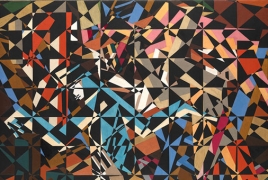Tate Sensorium, a new immersive art experience, unveiled at Tate Britain August 26, 2015 - 17:33 AMT PanARMENIAN.Net - Galleries are overwhelmingly visual. But people are not – the brain understands the world by combining what it receives from all five senses. Can taste, touch, smell and sound change the way we experience art? Tate Sensorium is the winning project of IK Prize 2015, an annual prize supported by the Porter Foundation, presented by Tate for an idea that uses innovative technology to enable the public to discover, explore and enjoy British art from the Tate collection in new ways. This immersive display opening on 26 August 2015 allows visitors to engage with paintings from Tate’s collection in a multisensory experience inspired by the artworks. Sound, smell, taste and touch are used to highlight different aspects of each painting and explore the way the senses interrelate to influence our overall gallery experience. Featuring works by four celebrated figures in twentieth-century painting, Francis Bacon, David Bomberg, Richard Hamilton and John Latham, the display will encourage a new approach to interpreting these paintings, using the senses to trigger both memory and imagination. Key technological components include the use of Binaural and directional audio to produce 3D sounds, a perfume release system to heighten scent and pioneering touchless haptics technology to create the impression of tactile sensations, Art Daily reports. Selected from a shortlist of four proposals earlier this year, Tate Sensorium is produced by creative studio Flying Object in collaboration with a cross-disciplinary team including audio specialist Nick Ryan; master chocolatier Paul A Young; scent expert Odette Toilette; interactive theatre maker Annette Mees; lighting designer Cis O’Boyle; and the Sussex Computer Human Interaction Lab team lead by Dr Marianna Obrist at the Department of Informatics, University of Sussex. Visitors will be given the option to track their response to the display by wearing biometric measurement devices that record the emotional impact of the experience. These wristbands monitor electrodermal activity, a measure of perspiration, which indicates how calm or excited the wearers are. On leaving the experience, each visitor is awarded a tailored summary of how their body reacted to the exhibits and invited to explore the rest of the gallery using the theme of the senses as a guide. Flying Object said: “Developing Tate Sensorium over the past six months has been a fascinating creative challenge. Our goal is to create an experience that provokes, rather than presents, interpretation of the art; we want visitors to enjoy the experience but more importantly to connect with the art in personal, memorable ways. We’ve been fortunate to work with really talented people on developing the sensory stimuli, and we’re excited to bring cutting edge technology into the gallery space to help bring the experience to life.” The IK Prize, named in memory of the philanthropist Irene Kreitman, celebrates creative talent in the digital industry. Supported by the Porter Foundation, the Prize is presented by Tate to a team, company or individual for an original idea that uses the power of digital technology to connect Tate’s collection of 500 years of British Art to a wider audience. This is the second year of the IK Prize. The inaugural winners were The Workers for After Dark, a project featuring robots in the collection displays at Tate Britain. Photo: Tate The creative crew of the Public TV had chosen 13-year-old Malena as a participant of this year's contest. She called on others to also suspend their accounts over the companies’ failure to tackle hate speech. Penderecki was known for his film scores, including for William Friedkin’s “The Exorcist”, Stanley Kubrick’s “The Shining”. The festival made the news public on March 19, saying that “several options are considered in order to preserve its running” Partner news |